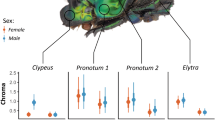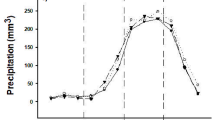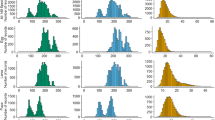Summary
Measurements of metabolic rate in the terrestrial miteAlaskozetes antarcticus showed that the ability for metabolic temperature compensation is lacking in adults of this species. Animals cultured at 0 and 10°C displayed similar metabolic rates when transferred to 5 or 10°C, and individuals cultured at 0°C and measured at 0, 5 and 10°C showed the same metabolic response as animals cultured and measured at each of these temperatures. These findings, which suggest thatA. antarcticus does not regulate its metabolism in response to changes in temperature, are discussed in the context of the environmental temperature patterns experienced by the animal in the field.
Similar content being viewed by others
References
Berthet, P.: L'activité des Oribatides (Acari: Oribatidae) d'une Chênaie. Mém. Inst. Sci. Nat. Belg.152, 1–152 (1964)
Block, W.: Oxygen consumption of the terrestrial miteAlaskozetes antarcticus (Acari: Cryptostigmata). J. Exp. Biol.68, 69–87 (1977)
Block, W., Tilbrook, P.J.: Effects of long term storage on the oxygen uptake ofCryptopygus antarcticus (Collembola). Oikos29, 284–289 (1977)
Block, W., Young, S.R.: Metabolic adaptations of Antarctic terrestrial micro-arthropods. Comp. Biochem. Physiol.61A, 363–368 (1978)
Bullock, T.H.: Compensation for temperature in the metabolism and activity of poikilotherms. Biol. Rev.30, 311–342 (1955)
Feder, M.E.: Environmental variability and thermal acclimation in neotropical and temperate zone salamanders. Physiol. Zool.51, 7–16 (1978)
Goddard, D.G.: The Signy Island terrestrial reference sites: VI. Oxygen uptake ofGamasellus racovitzoi (Trouessart) (Acari: Mesostigmata). Bull. Br. Antarct. Surv.45, 1–11 (1977a)
Goddard, D.G.: The Signy Island terrestrial reference sites: VIII. Oxygen uptake of some Antarctic prostigmatid mites (Acari: Prostigmata). Bull. Br. Antarct. Surv.45, 101–115 (1977b)
Hazel, J.R., Prosser, C.L.: Molecular mechanisms of temperature compensation in poikilotherms. Physiol. Rev.54, 620–677 (1974)
Holter, H.: Technique of the Cartesian Diver. C.R. Trav. Lab. Carlsberg Ser Chim.24, 399–478 (1943)
Ivleva, I.V.: Quantitative correlation of temperature and respiratory rate in poikilothermic animals. Pol. Arch. Hydrobiol.20, 283–300 (1973)
Linderstrøm-Lang, K.U.: On the theory of the Cartesian Diver microrespirometer. C. R. Trav. Lab. Carlsberg Ser. Chim.24, 333–398 (1943)
Luxton, M.: Studies on the oribatid mites of a Danish beech wood soil II. Biomass, calorimetry and respirometry. Pedobiologia15, 161–200 (1975)
Marsden, I.D.: Effect of temperature on the microdistribution of the isopodSphaeroma rugicauda from a saltmarsh habitat. Mar. Biol.38, 117–128 (1976)
Newell, R.C.: Biology of intertidal animals. London: Logos Press 1970
Newell, R.C.: Environmental factors affecting the acclimatory responses of ectotherms. In: Effects of temperature on ectothermic organisms. Wieser, W. (ed.), pp. 151–164. Berlin, Heidelberg, New York: Springer 1973a
Newell, R.C.: Factors affecting the respiration of intertidal invertebrates. Am. Zool.13, 513–528 (1973b)
Newell, R.C., Wieser, W., Pye, V.I.: Factors affecting the oxygen consumption in the woodlousePorcellio scaber. Oecologia (Berl.)16, 31–51 (1974)
Newell, R.C., Roy, A., Armitage, K.: An analysis of factors affecting the oxygen consumption of the isopodLigia oceanica. Physiol. Zool.49, 109–137 (1976)
Ostle, B.: Statistics in research. Ames: Iowa State University Press 1963
Precht, H., Christophersen, J., Hensel, H., Larcher, W.: Temperature and life. Berlin, Heidelberg, New York: Springer 1973
Prosser, C.L.: Physiological adaptations in animals. In: Physiological adaptation to the environment. Vernberg, F.J. (ed.), pp. 3–18. New York: Intext Educational Publishers 1975
Riddle, W.A.: Comparative respiratory physiology of a desert snailRabdotus schiedeanus, and a garden snail,Helix aspersa. Comp. Biochem. Physiol.56A, 369–373 (1977)
Somero, G.N., Giese, A.C., Wohlschlag, D.E.: Cold adaptation of the Antarctic fish,Trematomus bernachii. Comp. Biochem. Physiol.26, 223–233 (1968)
Ulbricht, R.J., Prichard, A.W.: Effect of temperature on the metabolic rate of sea urchins. Biol. Bull. (Woods Hole)142, 178–185 (1972)
Walton, D.W.H.: Radiation and soil temperatures 1972–1974: Signy Island terrestrial references sites. Br. Antarct. Surv. Data1 (1977)
Webb, N.R.: Temperature and respiratory metabolism in a species of soil mite. In: Proceedings of 2nd International Congress of Acarology. Evans, G.O. (ed.), pp. 61–66. Budapest: Hungarian Academy of Sciences 1969
Young, S.R.: Respiratory metabolism ofAlaskozetes antarcticus. J. Insect Physiol. (in press) (1979)
Zeuthen, E.: Microgasometric methods: Cartesian Divers. In: 2nd International Congress of Histo- and Cytochemistry. Schiebler, T.H., Pearse, A.G.E., Wolff, H.H. (eds.), pp. 70–80 New York: Wiley 1964
Author information
Authors and Affiliations
Rights and permissions
About this article
Cite this article
Young, S.R. Effect of temperature change on the metabolic rate of an antarctic mite. J Comp Physiol B 131, 341–346 (1979). https://doi.org/10.1007/BF00688809
Accepted:
Issue Date:
DOI: https://doi.org/10.1007/BF00688809




